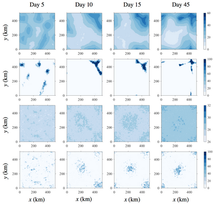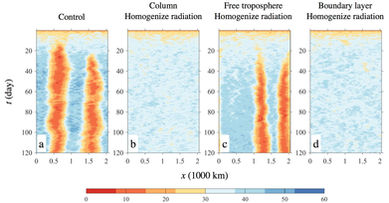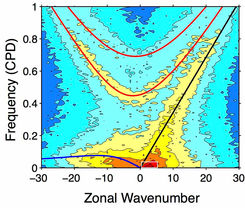top of page
Research highlight
“Everything should be made as simple as possible, but no simpler.”
Research highlight
Below is a brief introduction to a selection of papers led by our research group.
Poleward water vapor transport in the midlatitudes mainly occurs in meandering filaments of intense water vapor transport, spanning thousands of kilometers long and hundreds of kilometers wide and moving eastward. The water vapor filaments are known as atmospheric rivers (ARs). They can cause extreme wind gusts, intense precipitation, and flooding along densely populated coastal regions. Many recent studies about ARs focused on the statistical analyses of ARs, but a process-level understanding of ARs remains elusive. In a preprint, we show that ARs are streams of air with enhanced vapor kinetic energy (VKE) and derive a governing equation for Integrated VKE (IVKE) to understand what contributes to the evolution of ARs. We find that ARs grow mainly because of potential energy conversion to kinetic energy, decay largely owing to condensation and turbulence, and the eastward movement is primarily due to horizontal advection of VKE. Our VKE framework complements the integrated vapor transport framework, which is popular for identifying ARs but lacks a prognostic equation for understanding the physical processes.
Humid air is lighter than dry air at the same temperature and pressure because the molecular weight of water vapor is less than that of dry air. This effect is known as vapor buoyancy (VB). In this work we use a 3D general circulation model (GCM) to show that VB warms the tropical free troposphere and leads to a significant increase in outgoing longwave radiation (OLR). This radiative effect increases with climate warming, causing a negative climate feedback there. We call this the VB feedback. Notably, 1D, 2D, and 3D models consistently indicate that the VB feedback strengthens with warming.
Also see Yang et al. (2022), Yang and Seidel (2023), Seidel and Yang (2020), and Yang and Seidel (2020).
The Madden-Julian Oscillation (MJO) has long been a mystery in tropical atmospheric dynamics. A paper in GRL uses the E3SM-MMF, a superparameterized climate model, to investigate whether radiative feedbacks are essential for simulating the MJO. Through vertically resolved MSE diagnoses and mechanism-denial experiments, the study demonstrates that the MJO can still self-emerge and maintain its characteristic structures even in the absence of radiative feedbacks.
Previous research showed that radiative feedbacks are essential to the spontaneous development of convective aggregation (CSA) in idealized atmosphere models. A paper in GRL finds that the contribution of radiative feedbacks decreases with warming and that, in warm climates, CSA occurs without radiative feedbacks. This result agrees with the vertically resolved moist static energy diagnosis.
The molar mass of water vapour is less than that of dry air, making humid air lighter than dry air at the same temperature and pressure. This effect is known as vapour buoyancy and has been considered negligibly small in large-scale climate dynamics. A paper in Nature Geoscience shows that vapour buoyancy has a similar magnitude to thermal buoyancy in the tropical free troposphere. We further show that vapour buoyancy makes cold air rise and increases subtropical stratiform low clouds by up to 70% of its climatological value. However, some widely used climate models fail to represent vapour buoyancy in the governing equations. This flaw leads to inaccurate simulations of cloud distributions—the largest uncertainty in predicting climate change.
A paper in JCLI presents 123 cloud-resolving simulations to study how temperatures of anvil clouds and radiative tropopause (RT) change with surface warming. Our simulation results show that the RT warms at approximately the same rate as anvil clouds. This relationship persists across a variety of modeling choices, including surface temperature, greenhouse gas concentration, and the representation of radiative transfer. We further show that the shifting ozone profile associated with climate warming may give rise to a fixed RT temperature as well as a fixed anvil temperature. This result points to the importance of faithful treatment of ozone in simulating clouds and climate change.
Tropical cyclones (TCs) are among the most intense and feared storms in the world. What physical processes lead to cyclogenesis remains the most mysterious aspect of TC physics. Previous studies proposed that spontaneous TC genesis requires either radiative or surface-flux feedbacks. A paper in JAS shows that TCs can self-emerge even without radiative and surface-flux feedbacks in cloud-resolving simulations. We show that TC genesis is associated with an increase in the available potential energy (APE) and that convective heating dominates the APE production. Our result suggests that spontaneous TC genesis may result from a cooperative interaction between convection and circulation and that radiative and surface-flux feedbacks accelerate the process.
Randomly distributed convective storms can self-aggregate in the absence of large-scale forcings. A paper in JAS presents a 1D shallow-water model to study the convective self-aggregation. This model can successfully simulate self-aggregation, and the results are robust to a wide range of parameter values. In the simulations, convection excites gravity waves. The gravity waves then form a standing wave pattern, separating the domain into convectively active and inactive regions. By performing dimensional analysis, we develop a scaling theory for the size of convective aggregation, which is set by the gravity wave speed, damping time scale, and number density of convective storms. This paper provides a simple modeling framework to further study convective self-aggregation.
Moist air is lighter than dry air at the same temperature, pressure, and volume because the molecular weight of water is less than that of dry air. We call this the vapor buoyancy effect. Although this effect is well documented, its impact on Earth’s climate has been overlooked. A paper in Sci. Adv. uses theory and cloud-resolving simulations to show that the lightness of water vapor helps to stabilize tropical climate by increasing the outgoing longwave radiation (OLR). For example, at a near present-day surface temperature, vapor buoyancy is responsible for a radiative effect of 1 W/m2 and a negative climate feedback of about 0.15 W/m2 per kelvin.
The molar mass of water vapor is much less than that of dry air. This makes a moist parcel lighter than a dry parcel of the same temperature and pressure. This effect is known as the vapor buoyancy effect and has often been overlooked in climate dynamics. Using satellite observations, a paper in JCLI shows that vapor buoyancy makes the air warmer by about 1 K over dry regions in the tropical atmosphere, and this additional warming can effectively increase Earth’s thermal emission. A simple model shows that the negative radiative effect increases with warming, stabilizing Earth’s climate.
Convective storms can self-aggregate, forming large-scale overturning circulations. What physical processes can lead to self-aggregation of convection? A paper in GRL shows that convective heating and its feedback with large-scale circulations can lead to self-aggregation even in the absence of radiative, surface-flux, and moisture-entrainment feedbacks.
What sets the spatial scale of convective self-aggregation? A paper in JAS presents a boundary layer theory for the horizontal scale of 2D (x, z) convective self-aggregation by considering both the momentum and energy constraints for steady circulations. This theory is verified using a suite of cloud-resolving simulations.
What leads to convective self-aggregation? Combining energetic analyses and mechanism-denial experiments, a paper in JAMES proposes that the development of self-aggregation requires the generation of available potential energy (APE), and that boundary layer diabatic processes dominates the APE production.
The Madden-Julian Oscillation (MJO) is often described as a planetary-scale phenomenon that only occurs over the warmest water on Earth. However, a paper in JCLI shows that the MJO can still occur even over an extremely cold ocean surface, and that the spatial scale of the MJO shrinks to the synoptic scale in cold climates.
What sets the spatial scale of the Madden-Julian Oscillation (MJO)? A paper in GRL presents a scaling theory for the zonal scale of the MJO based on a suite of shallow water model simulations and dimensional analysis. Our results suggest that the zonal scale of the MJO increases with the gravity wave speed and decreases with the number density of convection.
The Madden-Julian Oscillation (MJO) is a month-long, planetary-scale phenomenon in the tropical atmosphere. Although it was first discovered about 50 years ago, there is no widely-accepted theory, and many climate models do not capture it. In a paper in JAS, we present a one-layer shallow water model that can successfully simulate the MJO. Based on the simulation results, we propose that the MJO is a large-scale envelope of short-lived, small-scale gravity waves.
Atmospheric blocks are characterized by large-scale persistent pressure patterns that redirect jet streams. It is generally thought that forced quasi-stationary planetary waves by land-sea contrast and orography are critically important in the onset and maintenance of blocking. However, a paper in GRL shows that blocking systems can occur frequently over an aquaplanet.
bottom of page
















